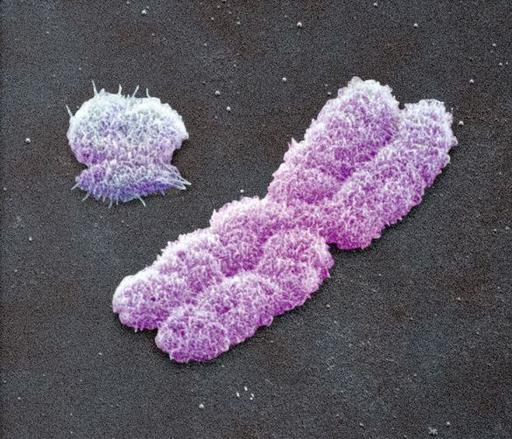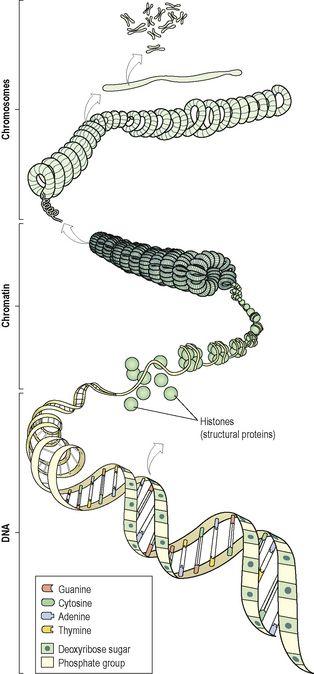Ross & Wilson Anatomy and Physiology in Health and Illness (198 page)
Read Ross & Wilson Anatomy and Physiology in Health and Illness Online
Authors: Anne Waugh,Allison Grant
Tags: #Medical, #Nursing, #General, #Anatomy

Figure 17.2
Coloured scanning electron micrograph of replicated human sex chromosomes:
Y upper left, X centre.
Genes
Along the length of the chromosomes are the genes. Each gene contains information in code that allows the cell to make (almost always) a specific protein, the so-called
gene product
. Each gene codes for one specific protein, and research puts the number of genes within the human genome at 24 500 – that means 24 500 different proteins.
Genes normally exist in pairs, because each gene site (locus) is present at corresponding sites on both homologous chromosomes (
p. 433
).
DNA
Genes are composed of very long strands of DNA; the total length of DNA in each cell is about a metre. Because this is packaged into chromosomes, which are micrometres (10
−6
m) long, this means that the DNA must be tightly wrapped up to condense it into such a small space.
DNA is a double-stranded molecule, made up of two chains of
nucleotides
. Nucleotides consist of three subunits:
•
a sugar
•
a phosphate group
•
a base.
The DNA molecule is sometimes likened to a twisted ladder, with the uprights formed by alternating chains of sugar and phosphate units (
Fig. 17.3
). In DNA, the sugar is deoxyribose, thus
D
NA. The bases are linked to the sugars, and each base binds to another base on the other sugar/phosphate chain, forming the rungs of the ladder. The two chains are twisted around one another, giving a double helix (twisted ladder) arrangement. The double helix itself is further twisted and wrapped in a highly organised way around structural proteins called
histones
, which are important in maintaining the heavily coiled three-dimensional shape of the DNA. The term given to the DNA–histone material is
chromatin
. The chromatin is supercoiled and packaged into the chromosomes (
Fig. 17.4
).
Figure 17.3
Deoxyribonucleic acid (DNA).
Figure 17.4
The structural relationship between DNA, chromatin and chromosomes.
The genetic code
The function of DNA is carrying huge amounts of information that determines all biological activities of an organism, and which is transmitted from one generation to the next. The key to how this information is kept is found in the bases within DNA. There are four bases:
•
adenine (A)
•
guanine (G)
•
thymine (T)
•
cytosine (C).
They are arranged in a precise order along the DNA molecule, making a code that can be read when protein synthesis is required. Each base along one strand of DNA pairs with a base on the other strand in a precise and predictable way. This is known as
complementary base pairing
. Adenine always pairs with thymine (and vice versa), and cytosine and guanine always go together. The bases on opposite strands run down the middle of the helix and bind to one another with hydrogen bonds (
Fig. 17.3
).
Mutation
Mutation means an alteration in the normal genetic make-up of a cell. Some mutations occur by chance, because of the countless millions of DNA replications and cell divisions that occur normally throughout life. Others may be caused by external factors, such as X-rays, ultraviolet rays or exposure to certain chemicals.
Sometimes the mutation is lethal, because it disrupts some essential cellular function, causing cell death. Often, the mutated cell is detected by immune cells and destroyed because it is abnormal (
p. 369
). Other mutations do not kill the cell but alter its function in some way that may cause disease, e.g. in cancer (
p. 49
). Mutations in the genetic material present in the gametes may be passed on to the next generation, e.g. phenylketonuria (
p. 435
).
Protein synthesis
Learning outcomes
After studying this section you should be able to:
describe the origin and structure of mRNA
explain the mechanism of transcription
outline the mechanism of translation.
DNA holds the cell’s essential biological information, written within the base code in the centre of the double helix. The products of this information are almost always proteins. Proteins are essential to all aspects of body function, forming the major structural elements of the body as well as the enzymes (
p. 24
) essential for all biochemical processes within it. The building blocks of human proteins are about 20 different amino acids. The cell’s DNA is too big to leave the nucleus, and therefore an intermediary molecule is needed to carry the genetic instructions from the nucleus to the cytoplasm, where proteins are made. This is called
messenger
(
m
)RNA. Protein synthesis is summarised in
Figure 17.5
.




